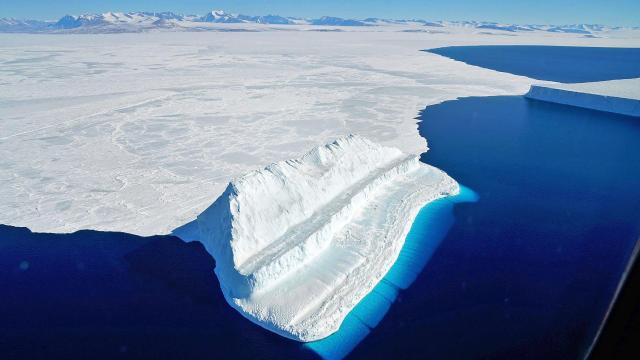If we keep on the path we’re on, Antarctica might be really, truly toast. A new study shows that the continent might hit a tipping point within this century if we don’t keep warming in check, and we might be in for dozens of feat of sea level rise as a result.
The study, published on Wednesday in Nature, uses computer models to see how the Antarctic ice sheet would respond if the globe warmed 1.5 degrees Celsius (2.7 degrees Fahrenheit) and 2 degrees Celsius (3.6 degrees Fahrenheit) — the targets set out in the Paris Agreement — by 2100. It also looked at what 5.4 degrees Fahrenheit (3 degrees Celsius) of heating by the end of the century, which is what the world is on track for right now under current commitments to the Paris Agreeement, could look like.
Meeting the 1.5 degrees Celsius and 2 degrees Celsius targets would mean that things in Antarctica are “basically almost indistinguishable” from what’s going on on the continent right now, said Rob DeConto, the paper’s lead author and co-director of the School of Earth and Sustainability at University of Massachusetts, Amherst. “You get the same rates of [ice] retreat, mainly in West Antarctica, the Amundsen Sea, the West Thwaites region. Nothing extraordinary happens, at least in this century.”
But things get intense when warming reaches 5.4 degrees Fahrenheit. In that scenario, the study finds really extreme ice loss begins by 2060 — a date that is way too close to right now for my comfort — pushing the continent past a tipping point that it would be nearly impossible for it to recover from. Sea levels would rise between 6.7 to 8.3 inches (17 to 21 centimeters) by the end of the century just from Antarctica melting — a huge step up from the 2.3 to 4.3 inches (6 to 11 centimeters) if the world meets the Paris Agreement target to limit warming to 2 degrees Celsius.
That’s just this century, though. Meeting that 2-degree-Celsius goal would result in Antarctica contributing 3.3 feet (1 m) to global sea level rise by 2300. It’s a not-inconsequential amount. But if countries fail to improve their climate ambitions and stick on the 5.4 degrees Fahrenheit track, it would mean an extra 33 feet (10 meters) of sea level rise — an almost incomprehensibly large jump.
“We really shouldn’t let the world reach 3 degrees Celsius [of warming],” DeConto said. “If we do, we’re screwed.”
A key component of understanding this huge difference is how the ice shelves in Antarctica seem to respond to warming. These enormous floating pallets of ice essentially act as buttresses to the larger ice sheets on land, protecting them from the ocean and providing structural support to keep them intact.
But when those shelves get too warm, they start to collapse and can’t protect the ice sheets any longer. It’s basically like popping the cork on a bottle of champagne that’s been shaken up, but this would be a mess on a planetary scale. It looks like that tipping point for ice shelf collapse is somewhere between 3.6 and 5.4 degrees Fahrenheit, DeConto said. “We’re seeing a threshold in the system, and we’re just adding too much heat. Things get set in motion.”
And it’s basically impossible to put that cork back in once it’s out. Even if we manage to develop geoengineering systems powerful enough to reverse warming and get the world’s temperatures back to the way they were before, it might not matter for Antarctica.
“Once the ocean warms up, it’s really hard to get an ice shelf to re-form in the warm ocean,” DeConto said. “Once these things get set in motion, like in warmer emissions scenarios where we get a lot of ice loss, it doesn’t stop, and it doesn’t stop even once we return to preindustrial temperatures. Even if the atmosphere cools back down, it takes a long time for the ocean to cool back down.”
Despite this incredibly dire finding, DeConto said there is good news to be gleaned from this research: Mainly that the Paris Agreement can and does prevent truly catastrophic changes in Antarctica. Taking aggressive climate action now means that we could stave off that 2060 tipping point and buy some time to figure out how to manage the world as it warms.
“Even the 2 degrees Celsius scenario is a favourable outcome,” DeConto said. “Yes, Antarctica will, like Greenland and like mountain glaciers, keep contributing to sea level rise, but hopefully at a pace that will be manageable for a lot of the world. Some places in the world aren’t going to be able to tolerate much more, if at all, in terms of sea level rise. But having half a millimetre per year of sea level rise from Antarctica versus half a centimeter per year in 2100 is really different.”
